MissionVet Specialty & Emergency
Orthopedic
Orthopedic surgery encompasses a wide range of joint and bone surgery. One of the more exciting and innovative aspects of orthopedic surgery is the ability to perform arthroscopy. Just as with people, arthroscopy allows us to visualize your pet’s joints with small cameras. Because of the smaller incision, your pet can go home sooner and be more comfortable. In addition, the high-definition camera gives a better view of the joint than the naked eye so that no abnormalities are missed. Treatment of cruciate and meniscal tears, as well as elbow dysplasia, are commonly performed with arthroscopy allowing for only 2-4mm (1/4 inch) skin incisions.
In addition to joint disease, Orthopedic surgery also focuses on the treatment of fractured bones. Using specialized bone plates or external fixators, we repair all forelimb, hindlimb, and pelvic fractures. In addition, we work closely with our board-certified Neurosurgeon on spinal fracture repairs.
Should Disorder
The most common condition that is treated with the shoulder of dogs is Osteochondritis Dessicans (OCD). This is often found in young, large breed dogs and is caused by an abnormality of the growth of the cartilage within the shoulder joint. This abnormal growth causes the cartilage to become thickened and eventually loosen from the underlying bone creating a flap of cartilage. This condition is treated by removing the fragment and debriding the underlying bone to allow fibrocartilage formation. This procedure is most often performed arthroscopically which decreases surgical time, postoperative pain, and recovery time. Most patients can be discharged on the same day after surgery. There is a very good prognosis for patients treated for shoulder OCD. Biceps tenosynovitis is also a painful condition of the shoulder that can be diagnosed and treated arthroscopically. It may result from trauma to the joint or from a soft tissue injury after strenuous activity. It is typically painful on palpation over the biceps tendon and can often be diagnosed on physical examination.
Fracture Repair
Fractures (broken bones) are often suffered by dogs and cats after some degree of trauma (falls, hit-by-car, etc.). The most common bones affected are the radius, tibia, humerus, femur, and pelvis. Some fractures in young animals can be treated with a cast or splint for several weeks. More complex fractures in adults often require surgical stabilization. This can be accomplished by numerous methods including plate/screw fixation, pins, wire, interlocking nail, and linear or circular external fixation. The method of repair will be determined by the location and severity of the fracture as well as patient and owner factors. We also have the capability of intra-operative fluoroscopy which allows us to evaluate the repair in real-time. This decreases surgical time which in turn decreases infection rate and decreases the anesthetic recovery time for the patients. Fluoroscopy also allows for minimally invasive plate osteosynthesis (MIPO) which can speed the healing time of the fracture. Healing time for most fractures ranges from 4-6 weeks in young animals to 8-10 weeks in adult animals.
PennHIP
PennHIP is a radiographic screening method used by PennHIP-certified veterinarians to assess, measure, and interpret hip joint status. Performed on dogs as young as 16 weeks of age, PennHIP’s primary objective is to reduce the frequency and severity of hip dysplasia in all breeds of dogs. Stored in and compared to an extensive collection of PennHIP data containing over 100,000 patients, PennHIP x-rays allow pet owners the ability to obtain an estimate of their dog’s risk for developing hip dysplasia and, if necessary, make lifestyle adjustments for their dog to enhance the quality of their pet’s life. PennHIP x-rays also allow breeders to confidently identify the members of their breeding stock with the best breeding potential. PennHIP was established in 1993 after 10 years of research by Dr. Gail Smith in evaluating a technique that quantified hip laxity. PennHIP has published more than 40 manuscripts over the past 20 years.
Arthrodesis
Arthrodesis is another term for fusion of a joint. This is needed when there is significant damage to a joint, either from trauma or severe arthritis. It prevents the joint from moving and therefore eliminates the pain associated with the painful condition in that joint. Depending on the condition the entire joint may need to be fused (pan-’joint’ arthrodesis) or only part of the joint may need to be fused (partial ‘joint’ arthrodesis). The most common joints that are fused are the carpus (wrist) and tarsus (ankle). The shoulder, elbow, and knee can also be fused but the need is much less common.
Cranial Cruciate Ligament Rupture (CrCLR)
This is the most common cause of a hind limb lameness in dogs. There are many theories as to why this ligament tears in dogs, but a single definitive cause has not been identified. We do know that the ligament slowly degenerates and tears with time and often can completely tear with minimal to no trauma. Approximately 40-60% of dogs that have a cruciate tear in 1 knee will have the other one tear at some point in their life. The main sign that is noted is limping in the affected leg. This can be as severe as not placing any weight on the limb or as mild as shifting weight off of the leg when standing. Cruciate tears can be diagnosed with a combination of physical exam findings as well as radiographs (x-rays) of the knee. The diagnosis is confirmed with an arthroscopic examination of the cruciate ligament at the time of surgery. Using arthroscopy as opposed to arthrotomy increases visualization of the joint, decreases post-operative pain, and increases patient use of the operated limb which speeds post-operative healing. There are several surgical treatment options for dogs with cruciate tears. The one that has shown to have the best short and long-term outcome is the Tibial Plateau Leveling Osteotomy (TPLO). This is a procedure that decreases the tibial slope to a point that eliminates the abnormal motion in the knee caused by the cruciate tear.
For dogs that have severe arthritis in the knee that is no longer responsive to medical management, we offer total knee replacements. This is a procedure that replaces both the femoral and the tibial components of the knee joint. It is very similar to the procedure that is performed on people for knee replacements.
Medical Patellar Luxation
Patellar luxation is a common finding in young small breed dogs but can also be found in large breed dogs. Even though your pet may have patellar luxation it may or may not require surgery. We recommend correction of patellar luxation in patients that are experiencing pain and lameness secondary to the luxation. You may notice that your dog skips on the affected leg or holds it up when running or walking. They may also stretch the leg backwards in order to replace the patella back in its normal location. There are 4 procedures that are most often required to correct the luxation. The normal groove that contains the patella often has to be deepened (trochleoplasty) to maintain the patella in the proper location. The attachment of the patellar tendon (tibial tuberosity) must be realigned with the remainder of the limb by cutting the bone and moving the tuberosity to a more normal location. When the patellar luxation occurs toward the medial (inward) of the knee this tissue must be released (retinacular release) to allow the patella to return to its normal location and the tissue on the lateral (outward) side of the knee must be tightened (fascial imbrication) to keep the patella in place.
Hip Dysplasia
Hip dysplasia is a common problem diagnosed in mainly large breed dogs. It is a developmental disorder that starts with increased laxity in the hip joints which leads to abnormal articulation and wear of the joint surfaces. This leads to the formation of arthritis as the dog ages which can cause it to be painful and difficult for the dog to rise, run, jump, and play as they did before. There are surgical options for hip dysplasia depends on the age of the dog. Juvenile Pubic Symphysiodesis (JPS) is a procedure that is designed for dogs between 16 weeks and 20 weeks of age. It causes a portion of the pelvis to be fused in a growing dog which causes the pelvis to grow in a way that actually increases the “tightness” of the joint. This decreases the wear of the joint and decreases the risk of arthritis in the future. Double Pelvic Osteotomy (DPO) is a procedure that is performed in young dogs (<1yr) that have laxity but no evidence of arthritis and relatively normal hip conformation. Two cuts are made in the pelvic bone that allow the acetabulum (cup) to be rotated over the femoral head, increasing the coverage and decreasing the progression of arthritis in the future. The best option for dogs with hip arthritis is a total hip replacement (THR). This procedure replaces the acetabulum (cup) as well as the femoral head (ball) to eliminate the pain associated with the cartilage damage and arthritis that has developed. A total hip replacement is as close to a normal hip as possible and can allow dogs to return to normal function after the post-operative recovery period. The second option for dogs with severe hip arthritis is a Femoral Head and Neck Ostectomy (FHO). This is a procedure where the femoral head and neck are removed from the socket joint. Scar tissue forms a “false joint” that eliminates the bone-on-bone contact associated with severe arthritis. This procedure is better tolerated in cats and small dogs (<20 pounds). Hip luxations can also be treated with an FHO or total hip replacement. More commonly we treat hip luxations with a Toggle Pin repair technique that allows your dog to maintain their own hip joint.
Elbow Dysplasia
Elbow dysplasia is a condition commonly diagnosed in large breed dogs (Labrador retriever, Golden retriever, Rottweiler, German Shepherds, Newfoundland, Bernese Mountain dogs) and is composed of several different components (Medial Coronoid Disease (MCD), Osteochondritis Dessicans (OCD), and Ununited Anconeal Process (UAP). Dogs can be affected by one or multiple components of this condition. In most cases, it can be treated arthroscopically which minimizes surgical trauma associated with a large incision into the joint and decreases post-operative pain and recovery time. The elbow is a very tight and congruent joint and any abnormality present can lead to the progression of arthritis. Some dogs diagnosed with this condition will require treatment of arthritis as the dog ages. This may be as simple as giving fish oil and joint supplements or as complex as requiring joint injections and rehab therapy.

